Mung Bean Sprouts, How to Sprout Mung Beans
Updated: November 23, 2024, By Swasthi
Mung Bean Sprouts aka Green Gram Sprouts – A complete step by step photo guide on How to Sprout Mung Beans at home. Sprouting Mung Beans at home is economical, hygienic and definitely comes with an added benefit of freshness. Most store bought sprouts sold are chemically treated and they come with a risk of contamination too. Homegrown sprouts are chemically free with zero risk of contamination if sprouted carefully.
Mung Bean also known as green gram or moong bean is a legume that is staple in many Asian Countries and is used to cook both sweet and savory dishes. In the regional Indian languages they are called as Pesalu in Telugu, hesarukalu in Kannada, pasi payaru in Tamil and sabut moong in Hindi.
About Mung Bean Sprouts
Mung Bean Sprouts, more commonly known as Bean Sprouts are the sprouts that grow from the soaked mung beans. Green gram are high in protein, fiber and vital nutrients. Sprouting not only enhances the nutrition of mung beans but also makes them easily digestible.
Sprouts contain higher levels of folate, Vitamin C, K, magnesium, phosphorus and anti-oxidants than the un-sprouted beans. Mung Bean Sprouts are used in preparation of various dishes like stir fry, salads, soups, curries and noodles.
Table of contents
Why Homemade?
Though these can be store bought, sprouting them at home is hygienic and you avoid the risk of contamination. Most often preservatives are added to the mung bean sprouts to increase their shelf-life.
There are several different methods followed in Asian countries to sprout mung beans. In this post I share with you 2 easiest ways to sprout mung beans with no extra equipment needed.
The first method is sprouting directly in a container – bowl, jar or box and the second method is to sprout in a cotton cloth. Both these methods will help you grow healthier, fresher and sweet smelling mung bean sprouts at home.
Growing up I would see my mom sprouting green gram in a white cloth. So I always follow this method as the sprouts taste best, sweeter and delicious. Since the mung beans are tied tightly with a cloth, the skin remains intact. This method also helps the sprouts grow thicker.
2 Benefits of Sprouting in Cloth
You don’t need to rinse the mung beans often in case you plan to grow the sprouts longer. The moist cloth wrapped around them keeps them moist for long time. If sprouting in a jar then you may require to rinse or sprinkle water every few hours depending on the temperature in your region.
Since the mung beans are tightly packed, they are forced to germinate sooner and thicker. This is similar to the technique where a heavy object is placed over the soaked seeds or beans, so they grow thicker.
If you are looking for more green gram recipes, you may like
Green gram dosa
Sprouted moong salad
Green gram curry
Photo Guide
How to Grow Mung Bean Sprouts (Stepwise photos)
1. Add half cup mung beans to a large bowl. Pick and discard stones and broken beans. Also if you find any shrunk and wrinkled beans discard them as well.
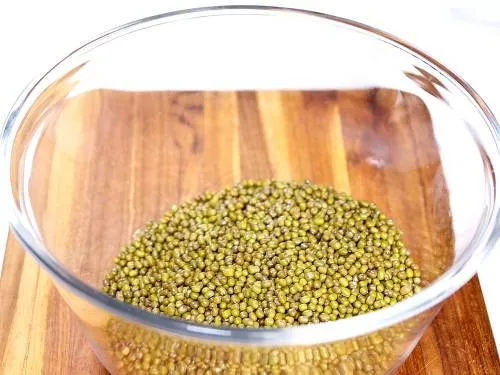
2. Rub and rinse them well in lots of water at least thrice or until the water runs clear. I prefer dechlorinated or boiled and cooled water for soaking.
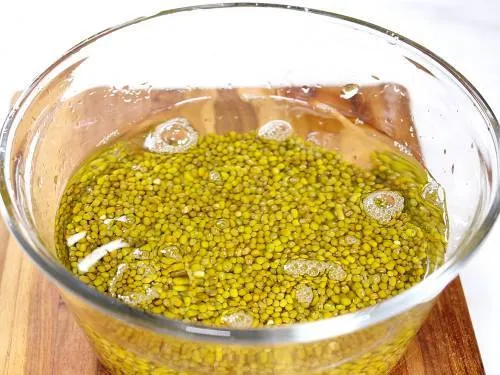
3. Soak them for at least 9 to 12 hours. Do not cover the bowl as we don’t want the sprouts to develop odor. I cover with a mess basket.
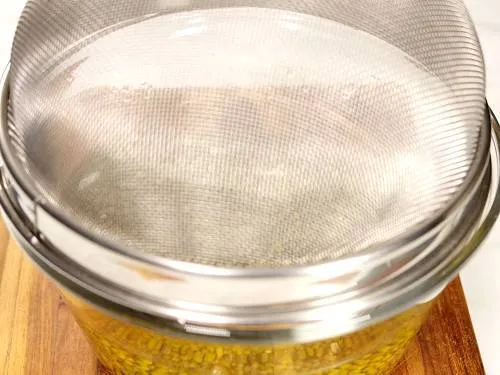
4. After 9 hours mine look like this. Some beans need a longer soak. The skin on the bean must be broken, that is the right time to begin sprouting them. Sometimes you might even see them begin to sprout on their own, while still soaking.
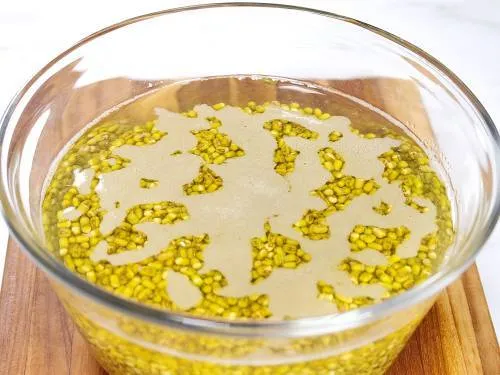
5. Discard the water and pour fresh water. Rinse them very well a few times again with clean water only. Drain them to a colander.
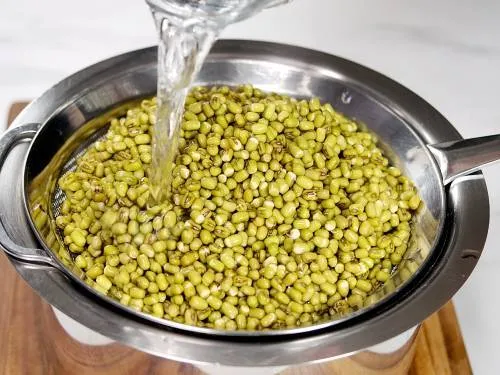
6. There are two methods to sprout.
Method 1 – Sprouting Mung Beans in a Jar
a. Transfer all the drained beans to a bowl/ jar or any container. Ensure there is no excess dripping water as the green beans can develop an odor.
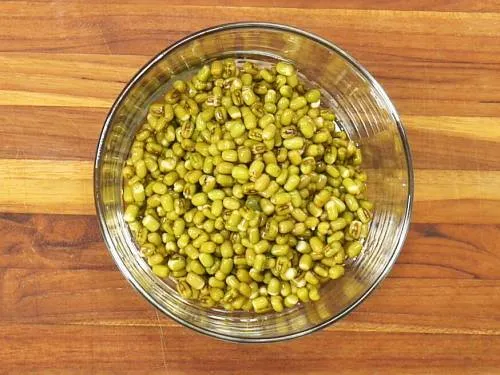
Cover partially and keep the bowl in a dark and warm place away from sunlight. Do not cover completely. They sprout on their own.
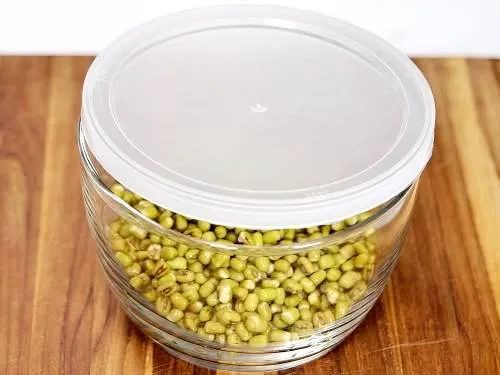
Mine sprouted this long in 12 hours. I did not rinse them in between. Check after 12 hours. If you want longer sprouts, rinse them and drain completely. Cover partially and keep them back in dark and warm place. If you live in a very hot place, then you may need to sprinkle water every few hours.
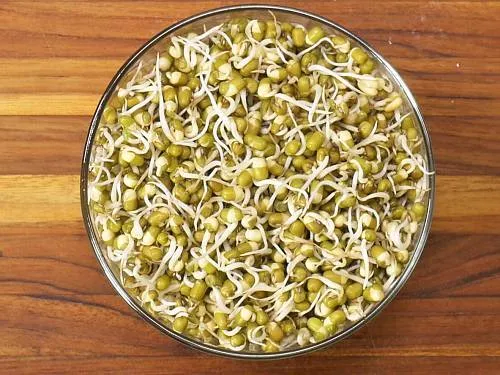
Method 2 – Sprouting in a Cloth
b. Rinse and squeeze off excess water from a clean muslin or thin cotton cloth. Spread it and pour the drained mung beans.
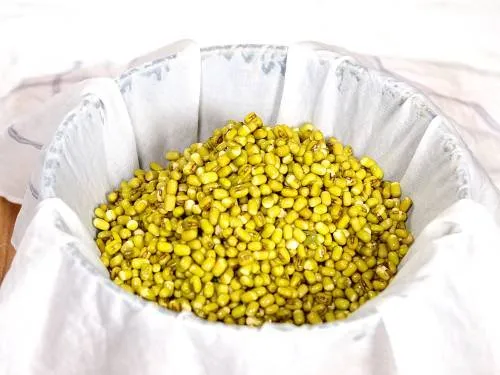
Bring together all the edges, roll tightly and make a knot to bundle the mung beans. Rolling tightly helps the sprouts grow thicker & this technique is similar to where a heavy object is placed over soaked seeds or beans so they grow thicker sprouts. Place it in a container & cover it partially. Move it to a warm and dark place.
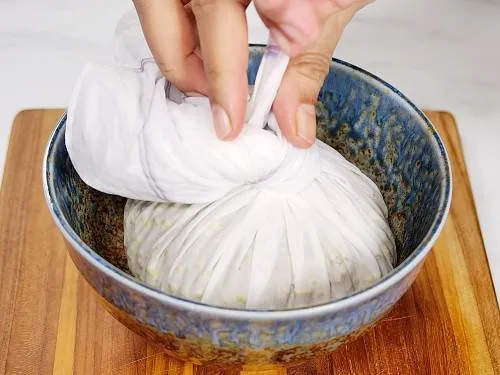
Depending on the weather conditions, they will begin to sprout. Sometimes they even sprout in just 3 to 4 hours. They can even take a day to sprout well. After 8 hours, mine were like seen in the pictures.
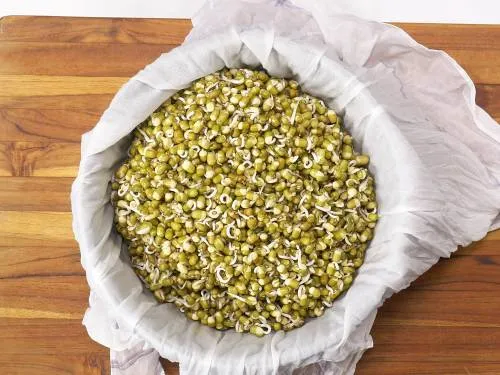
I bundled it again and sprinkled some water. Let all the excess water drain and kept it back for another 12 hours. The green beans had sprouted long enough so they were seen through the cloth.
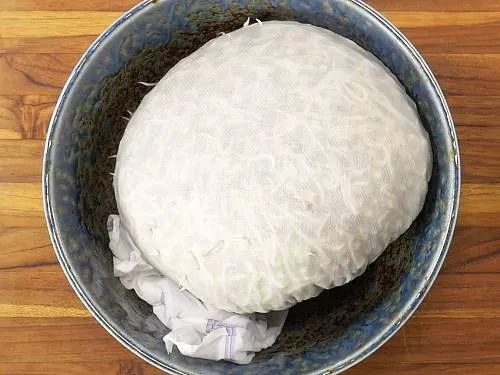
If the climate is too hot, and the cloth dries up, sprinkle some water on the cloth to keep the beans moist. But ensure there is no excess water drippings as they can rot or develop an odor.
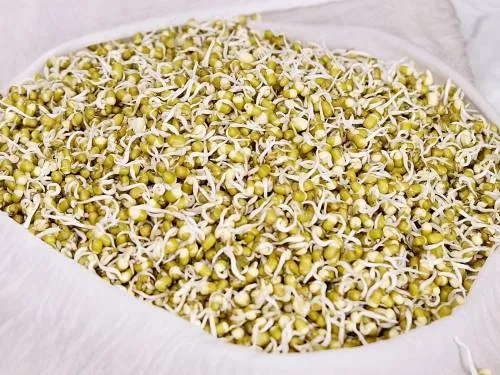
The sprouts in this bowl were from another time when they sprouted in just 3 hours.
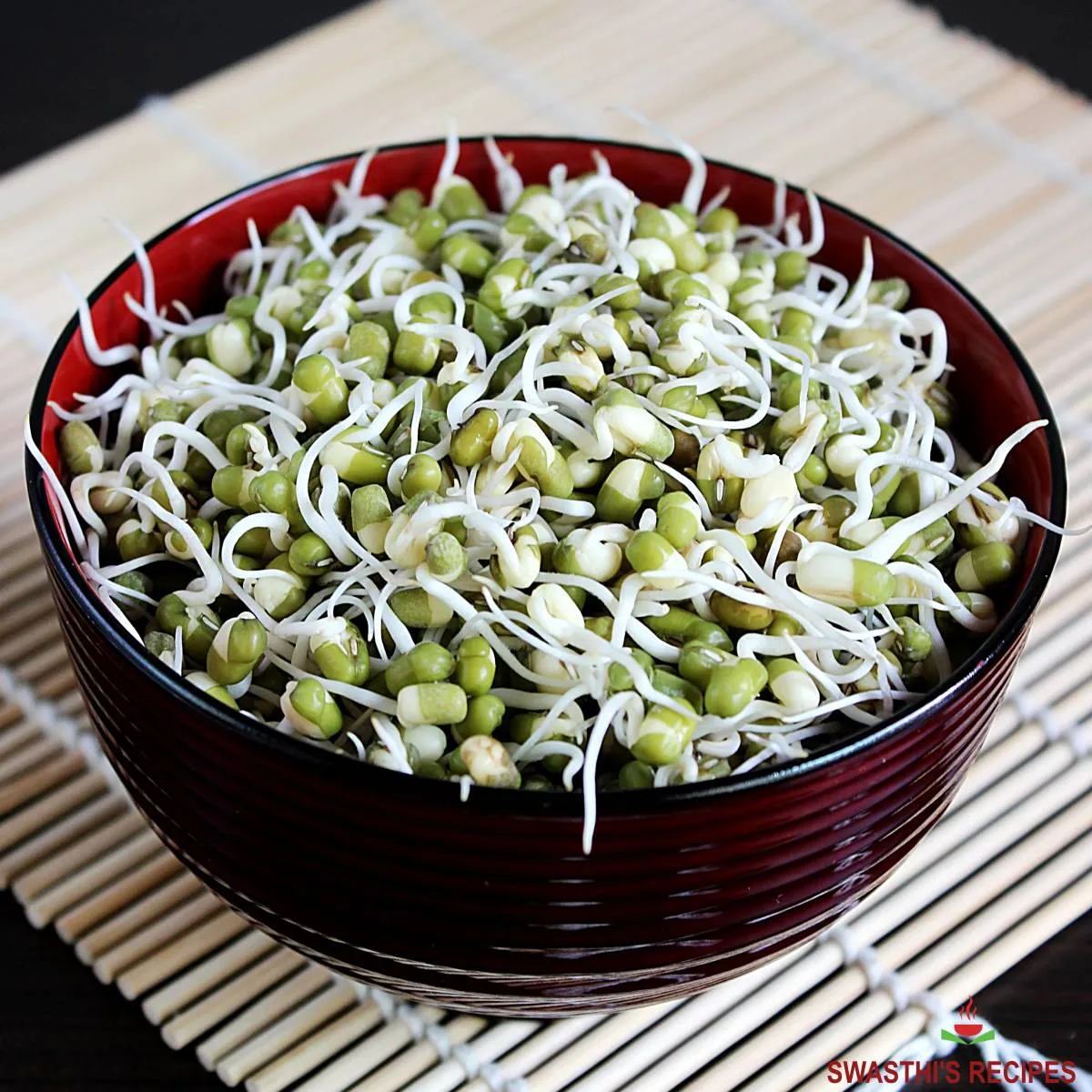
How to Store and Use
Sprouted mung beans stay best and fresh for 1-2 days in refrigerator. It is good to consume them fresh. However they can be stored for 2 days. At home we mostly eat them on the same day or store the leftovers in a glass container. Sprouts if left longer at room temperature or in the fridge can develop bacteria, for the same reason stored sprouts require cooking them thoroughly before consumption. This reduces the risk of stomach & digestive upsets.
Avoid rinsing sprouts if you prefer to store them. Store them right away when they are ready.
Mung bean sprouts that sprout within 24 hours can be eaten raw after a good rinse in clean water. But beans that take longer to sprout can carry microorganisms so they are best stir fried or steamed before consumption.
You can simply steam them in a steamer or over a pot of boiling water for 3 to 4 minutes until steaming hot. They can also be steamed in the instant pot or pressure cooker for 0 minutes, followed by a quick manual release. Simply season them with your favourite seasonings, lemon juice and salt.
Alternately you can also make a tempering with Indian spices and ghee. Then add these steamed sprouts & fresh coconut. Sprinkle some lemon juice over it.
Apart from this you can simply add the raw bean sprouts while you stir fry your veggies. The options are endless.
Expert Tips
- Choose mung beans from a store where the stock is fresher. Green gram that has been harvested years ago do not sprout well.
- Organic mung beans take longer time to soak as well to sprout. Hybrid variety soak faster and sprout faster. So plan accordingly & adjust the soaking time.
- Always rinse the green beans with clean water at least 3 to 4 times to avoid the risk of contamination, Finally we use slightly hot water to rinse them.
- Ensure you use boiled and cooled water or filtered dechlorinated water to soak them.
- If using cloth rinse it well before using.
- Most times we eat raw sprouts so I prefer a final rinse with slightly hot water for 90 seconds (not boiling hot, 90 C)(why hot water? read my faq section below). Discard all the hot water after 90 seconds and pour fresh cool clean filtered water.
Faqs
If the beans are too old, meaning they were harvested long time ago they won’t sprout. Also low quality beans that look shrunk won’t sprout. Lastly if the beans are not soaked long enough they won’t sprout.
Bean sprouts can taste bitter if they are exposed to bright light during the process of sprouting. So always sprout them in a dark place. Also use dechlorinated water to soak the mung beans as the chlorine in the water can affect the taste and texture of the sprouts
Rinsing beans with hot water (90 C) for 90 seconds can inactivate the Escherichia coli and Salmonella organisms on the seeds. So this is an effective step to be taken before the mung beans are sprouted. Using hot water won’t affect the germination if the beans are of good quality.
This tip can significantly reduce the chances of contamination. It can also help people having difficulty digesting sprouts or having a stomach upset or diarrhea after eating them.
If you desire to have the sprouts raw, green gram should always be washed thoroughly in hot water and then soaked in boiled and cooled water. Not in tap water. Often sprouts get contaminated due to the water the beans are soaked in.
Beans that take days to sprout (more than a day) tend to grow microorganisms in them, leading to indigestion and bloating. Such sprouts always need to be cooked before serving.
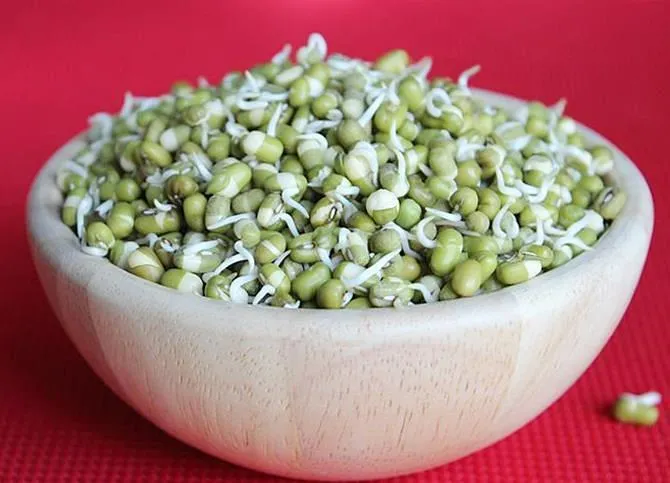
Related Recipes
Recipe Card
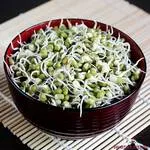
Mung Bean Sprouts, How to Sprout Mung Beans
For best results follow the step-by-step photos above the recipe card
Ingredients (US cup = 240ml )
- ½ cup mung beans / green gram
- 2 cups water to soak
Instructions
Preparation
- Add mung beans to a large bowl. First clean, pick and discard any stones or broken mung beans.
- Rinse them 3 to 4 times in lots of fresh clean water. While you do so rub the mung beans well and rinse. Discard the water completely.
- Pour fresh clean filter water and soak for at least 9 to 12 hours. I prefer to soak in dechlorinated or boiled and cooled water.
- If soaking for longer than 9 hours, discard and refill with fresh water. This prevents mung bean sprouts from developing an odor.
- When you are ready to sprout the mung beans, discard the water in which they were soaked. Rinse them at least 3 times with clean water. Drain to a colander.
How to Sprout Mung Beans
- Method 1 – Transfer the soaked & drained mung beans to a jar or bowl or a container. Ensure there is no water in them as we don't want them to develop a odor. Cover partially with a loose lid or with a muslin /cheese cloth.
- Method 2 – Rinse a cotton cheese or muslin cloth and wring it to remove excess water. Spread the cloth and transfer the drained mung beans to the center of the cloth.
- Bring all the edges together. Make a knot and tie it to a bundle (potli). Place this in a deep bowl. (Check pictures in the post)
- Transfer the bowl/ jar to a warm and dark place away from sunlight. Leave it undisturbed till they sprout. The time to sprout depends on the temperature. Some mung beans sprout within hours and some take as much as a day or two.
- After 12 hours check them if they have sprouted. If you prefer to grow them longer, sprinkle some clean water and let all of the excess water drain from the bundle or the jar/bowl. Any excess moisture left in the mung beans can rot them easily. Keep the bowl again in the same warm and dark place so they grow longer.
- Within 24 hours mung beans should sprout otherwise it means they are dead.
- Refrigerate the mung bean sprouts in a clean dry air tight jar or a container with holes. Use with in 2 days. To avoid the risk of bacteria, cook them thoroughly before adding to salads. Alternately use them in soups, stir fry and curries.
Notes
- As an extra precaution I rinse the mung beans last time with hot water for 90 seconds only (not very hot boiling water). This step helps in better germination and reduces the risk of contamination.
Video
NUTRITION INFO (estimation only)
© Swasthi’s Recipes
About Swasthi
I’m Swasthi Shreekanth, the recipe developer, food photographer & food writer behind Swasthi’s Recipes. My aim is to help you cook great Indian food with my time-tested recipes. After 2 decades of experience in practical Indian cooking I started this blog to help people cook better & more often at home. Whether you are a novice or an experienced cook I am sure Swasthi’s Recipes will assist you to enhance your cooking skills. More about me
Follow Swasthi’s Recipes

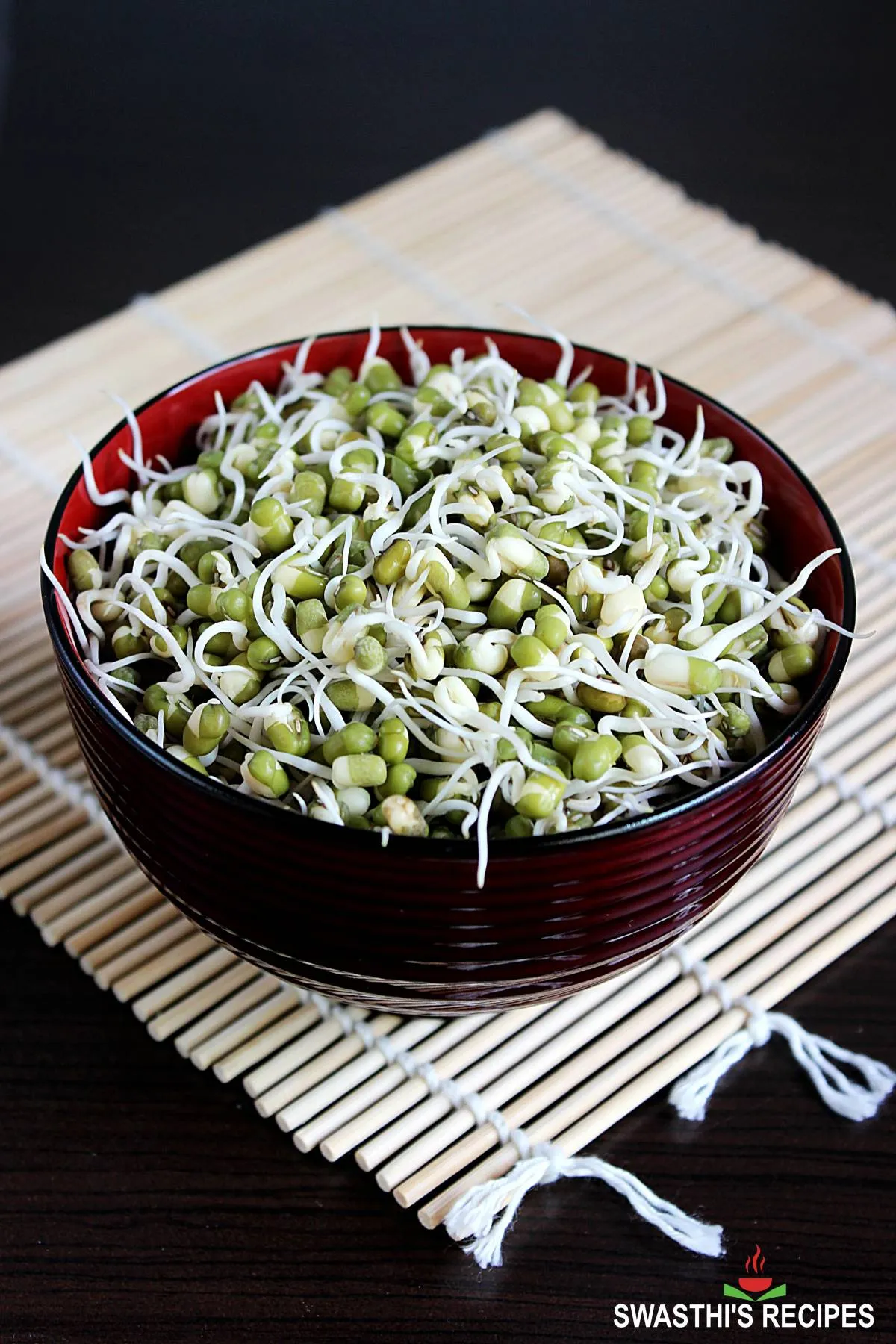


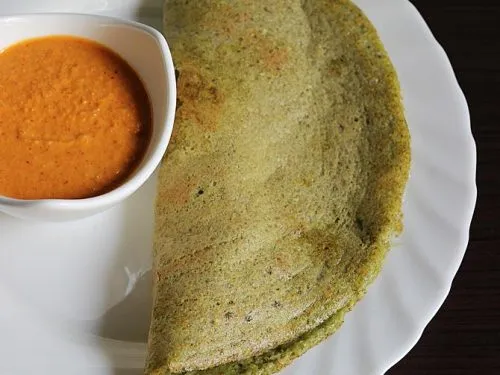
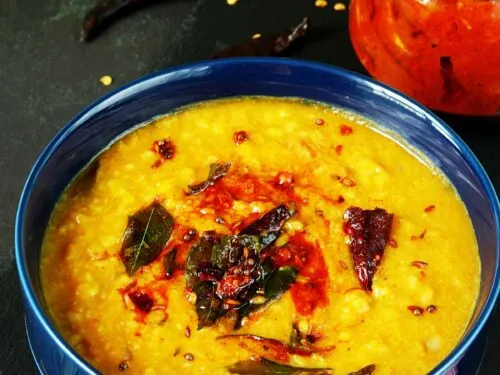

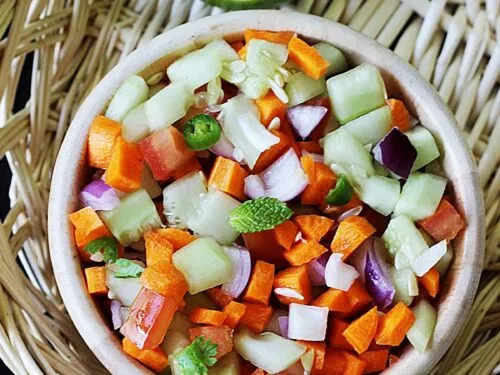
Comments
Wah bahut khub badiya recipe mujhe bahut help mili isse
I soaked my moong daal overnight for over 12 hours.
Rinse them. Drained it.
Put it a glass container and put in the oven since it’s dark there.
It’s been 3 days and they haven’t sprouted. What am I doing wrong??
Hi Gee,
The beans also require some warm temperature to sprout. It may be cold or at least not warm in your oven. That’s the reason they didn’t sprout. Transfer to a steel container and turn on your oven at 110 F for a few hours. They should sprout. If your oven can’t go that low, then you may preheat the oven at the lowest settings for 10 to 15 mins. Turn off the oven and place the beans. But my concern is that if they have been sitting for 3 days, they would have begun to rot already. Please check. Hope this helps.
Do you have any experience with exposing the sprouts to sunlight after the sprouting is complete? Like for an hour or 2, and then straight into the fridge. Something about making them more nutritious?
What is the best way to get the mung sprouts long and thick for stir fry recipes? I usually buy these at the Asian store, but they are not very fresh no matter when I buy and use them.
Hi MS Swasthi :
Thank you very much for the wonderful recipes you post : They are very thorough, practical and I rarely go wrong following your directions.
Mung Bean sprouts : My daughter says it is not a good practice to store in an air tight(glass) container: Reason : It may cause Botulism : The bacteria thrive and grow in the sprouts if the environment is devoid of Oxygen… that is if the lid is closed.
Is it wise to leave the sprouts open in the fridge, that is without a cover ?
Hi Dr. Rama,
Glad the recipes work for you. I am unable to figure out any source that talks about botulism in refrigerated sprouts. It is best to consume raw sprouts immediately after they are ready. Leaving them longer in the fridge or outside can cause bacteria to grow, requiring them to cook before consumption. It may not be safe to leave your sprouts uncovered in the fridge because that can cause cross-contamination. I think you should eat them raw as soon as they are ready and store the rest in the refrigerator. But cook them thoroughly before eating. I will edit the post for your reference on storing and using the leftovers. Hope this helps.
Thank you for these precise information. I have sprouted green moong beans for the first time..and eating them raw as I’m reading your recipe. Now I know the dos and don’ts the next time.
Glad it was helpful Ran. Thank you
Perfect!
This is wonderful information I am going to try. Considering Moong, Mung beans, or Green Gram are a real superfood. Thanks for sharing.
This was amazing. Thank you for the recipe and how to.
I was told to use sprouting quality mung beans to sprout especially if I’m going to eat them raw uncooked. What kind of mung beans do you use and is it safe to eat them uncooked? These are not chemically treated like the readily available sprouts from the supermarkets which makes them bacteria-free.
Hi Jiji,
I don’t use any sprouting quality mung beans but prefer to use organic quality. I guess that has nothing to do with the safety. As mentioned in the recipe I rinse them thoroughly in hot water before soaking which makes them bacteria-free at that stage. But if the technique to sprout is not right or due to weather conditions mung bean sprouts can easily develop mold. So I suggest sprouting them in a warm dark place. If you live in a cold region use your preheated oven or oven with yogurt option or in the instant pot. This ensures you have fresh mung bean sprouts in a shortest span. I think you should try out once so you will understand it is easier than you think.
Many years ago I had several failed attempts and decided let go off. But always love them! This is a fantastic tutorial for sprouting mung beans. I was able to grow them so well at the first shot. I couldn’t believe my skills. I write this while I munch on these sweet and delicious beauties. Thank you!
That’s Awesome Olivia!
Thank you so much for letting me know how it worked for you.
My mungbeans have turned pinkish after 3 days. Have they gone bad? The “tails” are long 2-3 inches, and they taste ok and have been properly drained. Just hope I am not about to eat something that has gone off.
Hi Alexandra,
They turn pink if exposed to light. They are safe as long as they don’t taste bitter.
When do you do the hot rinse? After soaking, before sprouting, or after sprouting, before consuming? Can’t figure that part out.
Thank you!
You should do it before soaking. I have mentioned that in the faqs.
Your tap water must contain more trace nutrients than ours in Australia. It usually takes 72 hours here for the mung beans to shoot. It is the same when watching videos of “sprouting” sweet potatoes. Within a day or so they sprout in India – you must note that Indian water is not particularly “pure”. Using Brisbane water it takes a week or longer.
Yes may be! I don’t live in India
Excellent.
Thank you!
How to sprout soya beans, I tried but ultimately I have to throw it.
Hi,
soya needs longer soak ,for 24 hours and in between they need a good rinse as well. They are sprouted in a different way
Thankyou Sir. You explained it greatly .And I learned how to make sprouts from you.
So glad to know!
Hi Swasthi, thank you very much for explaining in rich detail how to sprout mung beans. My only problem is that at the end of the process some of my beans haven’t sprouted, but stayed hard. It’s a pretty annoying task to find and remove them one by one or to chew on them while eating. Could you tell me how to avoid this issue? Many thanks and all the best! 🙂
Hi Krisztian,
Thank you for the wishes! Sometimes the old beans are mixed with the new beans while packing. That results in some of the old beans not sprouting. Try with a different brand of mung beans that are fresher in stock.
green Mong Beans reveal the soft textured, flavor and health benefits. Sprout is benefits for health,
Mine has this terrible smell. Does this mean that what I have sprouted has gone bad? The sprouted beans are odorless, i suppose? Thanks in advance!
Yes they have gone bad. They should have a sweeter smell.
Oh my! I’m gonna do this again. Thanks for the reply!
thanks for the moong beans preparing tip madam